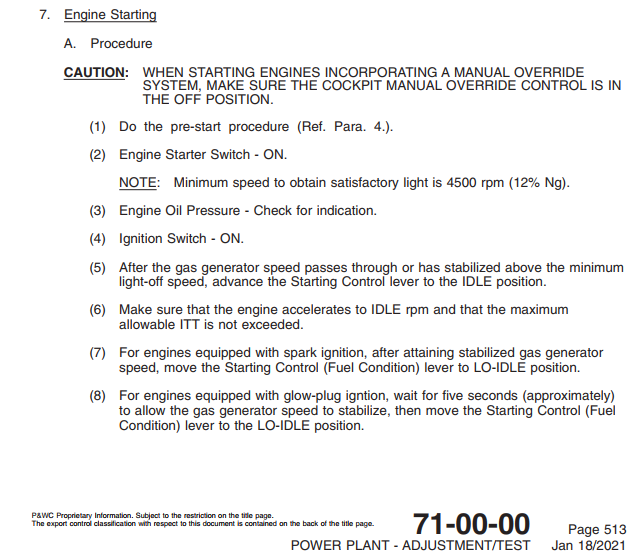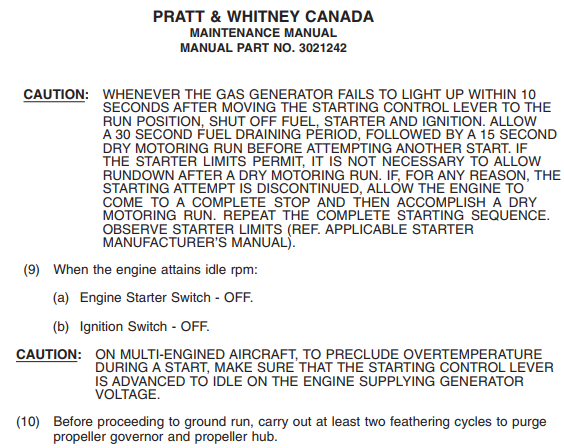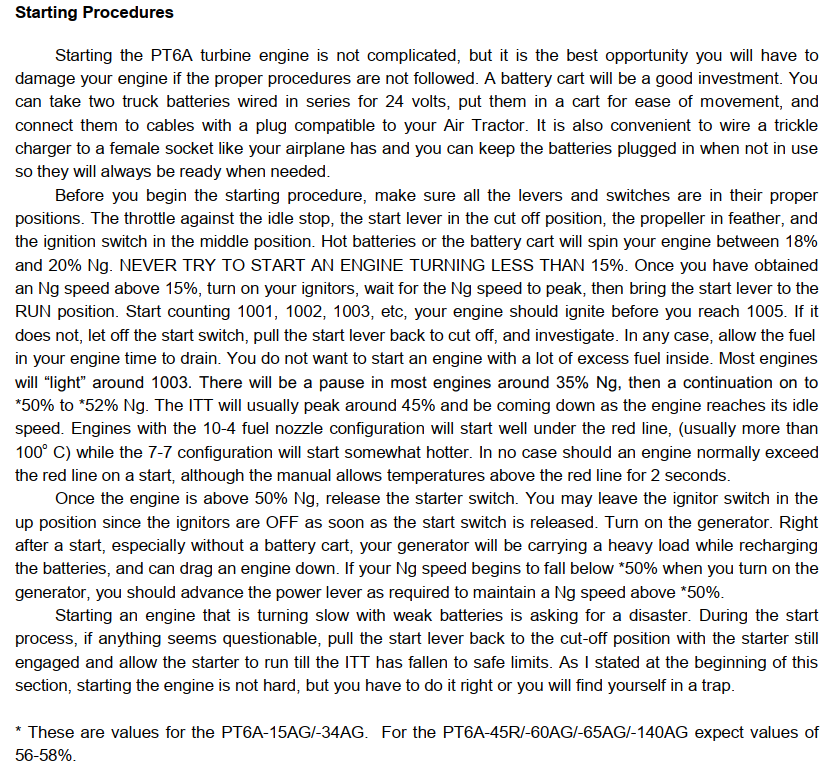PT6 Starting question
So if you are unable to unable to feather the prop then all the engine components keep spinning? I could see why you would want to remove an ignition source for a piston engine then. Perhaps itís an issue for a fixed turbine engine too or a regulatory throw back.
Iím just theorising here, hopefully someone will have a solid answer.
Company procedure on the idle stop.
The start isnít a big deal especially once used to it. Rather my point is the more you add to the process the more likely hood of something going wrong. I think itís good we do not also have to engage the igniters although Iím sure it could be managed.
Join Date: Jan 2009
Location: On a survey line somewhere...
Age: 42
Posts: 54
Likes: 0
Received 0 Likes
on
0 Posts
It's worth noting as well that the Air Tractors (at least the 502/504 that I'm familiar with), are VERY simple airplanes, with quite basic systems...and this seems to be baked into the design philosophy. Might be as simple as separate starter and igniter switches were seen as the simplest way to implement the start.
The igniter switch is a 3 position switch - start/on - off - on igniter continuous. In start/on, the igniters only come on with starter switch held on. In on igniter continuous, they're on continuous - there is no controller or other logic in the system as in many other airplanes.
The igniter switch is a 3 position switch - start/on - off - on igniter continuous. In start/on, the igniters only come on with starter switch held on. In on igniter continuous, they're on continuous - there is no controller or other logic in the system as in many other airplanes.
No. It's a free turbine. The only items driven by the Power Turbine on most PT6 fixed wing are the prop gov, PT ovspd gov, and PT tach/gen. Everything else is driven by the Compressor Turbine. My guess the reason for the AT igniter delay is more airframe electrical system related than anything else.
I suspect your point about the airframe electrical system is correct though.
Thread Starter
Join Date: Aug 2003
Location: LOS
Age: 67
Posts: 580
Likes: 0
Received 0 Likes
on
0 Posts
It's worth noting as well that the Air Tractors (at least the 502/504 that I'm familiar with), are VERY simple airplanes, with quite basic systems...and this seems to be baked into the design philosophy. Might be as simple as separate starter and igniter switches were seen as the simplest way to implement the start.
The igniter switch is a 3 position switch - start/on - off - on igniter continuous. In start/on, the igniters only come on with starter switch held on. In on igniter continuous, they're on continuous - there is no controller or other logic in the system as in many other airplanes.
The igniter switch is a 3 position switch - start/on - off - on igniter continuous. In start/on, the igniters only come on with starter switch held on. In on igniter continuous, they're on continuous - there is no controller or other logic in the system as in many other airplanes.
Join Date: Jan 2009
Location: On a survey line somewhere...
Age: 42
Posts: 54
Likes: 0
Received 0 Likes
on
0 Posts
I can understand the logic of having a separate ignitor switch for use in water washes, etc. In a helicopter we have to pull the CB for these or other reasons when we don't want ignitor activation with the starter. What I don't get is the need to turn that switch on at 12%, why not select it to Start/on, hit the starter and go from there just as we do with a RW installation.

PWC PT6-34AG MM Jan 18, 2021

PWC PT6-34AG MM Jan 18, 2021
This is from the Air Tractor Maintenance Manual:

Air Tractor AT-502A/502B/504 Maintenance Manual - Mar 14, 2019
So, interestingly, the PWC MM mentions 12% as the minimum Ng for a successful light....and that number is referenced in the AT pilot training course and official checklists as the value for when to turn on the ignitors. My guess is that they figure it's best not to introduce spark until past the bare minimum Ng that won't torch the engine, in the event that some fuel is present? It's also interesting that the AT MM lists 15% as the value to turn the igniters on.
I'd be curious to see the "official" answer from Air Tractor.
Company procedure on the idle stop.
The start isnít a big deal especially once used to it. Rather my point is the more you add to the process the more likely hood of something going wrong. I think itís good we do not also have to engage the igniters although Iím sure it could be managed.
The start isnít a big deal especially once used to it. Rather my point is the more you add to the process the more likely hood of something going wrong. I think itís good we do not also have to engage the igniters although Iím sure it could be managed.
Last edited by 212man; 6th Dec 2021 at 16:17.
Thread Starter
Join Date: Aug 2003
Location: LOS
Age: 67
Posts: 580
Likes: 0
Received 0 Likes
on
0 Posts
I have emailed AT to see if they have an answer. As I said earlier it was demonstrated to me once that a PT6 will not light until 12% as thats when the flow divider opens. I see their thought process in not turning the ignitors on until then in case there would be fuel in the can, but again if that is such a big concern with a PT6 then why is that not how it works in a RW installation. I really hate to say it, but I think that when AT switched from piston to turbines the test pilot was new to turbines and just thought this was a good idea with no real justification.
Just re-read the posting by sgs233a and see that for some unknown reason the P&W MM says to turn the ignitors on with a dash 34. Strange that in a 212 with a 3 or 3B engine they don't do this. Is there a difference in FCU? Flow divider? I would think other than power output and installation an old school PT6 is a PT6.
Just re-read the posting by sgs233a and see that for some unknown reason the P&W MM says to turn the ignitors on with a dash 34. Strange that in a 212 with a 3 or 3B engine they don't do this. Is there a difference in FCU? Flow divider? I would think other than power output and installation an old school PT6 is a PT6.
Last edited by Outwest; 6th Dec 2021 at 16:42.
Thread Starter
Join Date: Aug 2003
Location: LOS
Age: 67
Posts: 580
Likes: 0
Received 0 Likes
on
0 Posts
Itís been a while, but I think that procedure brings risks. With the idle stop open you donít know if you opened the throttle passed it. If you gave and get a hot start, Murthyís law dictates that the stop will close as you try and close the throttle, and attempts to release the stop will fail because youíre jamming it still trying to close the throttle! If you learn to feel the pressure of the cam, you will always know you have not passed it and can immediately snap the throttle closed. Iíve had hot starts and you need to be quick! Some werenít Ďrealí though and were due to faulty ITT compensators.
The specifics of the Ignition system for single-engine aircraft are very similar for either fixed or rotary-wing. When you have only one engine, there are operational circumstances that might increase the risk of engine failure or flame-out, and there are manoeuvering phases of flight that may have potentially disastrous outcomes that may be mitigated by the use of continuous ignition to relight an inadvertently flamed out engine. I have operated Caravans, MD500D's and B206's that all had continuous ignition options, and all specifically because they only had one engine.
In the normal modes, the ignition system is energized and operates in conjunction with the engine start switch, de-energizing when the start switch is disengaged. There is an additional selection that enables energizing the ignition system to run continuously unrelated to any other engine control selection. Typically, this selection would be made during take-off and landing, air starting, operation in blowing snow, heavy rain, icing, turbulence and low fuel conditions.
Without overthinking this, it is to allow single-engine aircraft a resource that will automatically relight the engine in the most likely scenarios that this could occur, or for emergencies when single-pilot workloads can be reduced by having this system already selected on.
If you only have one motor, you need to preserve it at all costs.
In the normal modes, the ignition system is energized and operates in conjunction with the engine start switch, de-energizing when the start switch is disengaged. There is an additional selection that enables energizing the ignition system to run continuously unrelated to any other engine control selection. Typically, this selection would be made during take-off and landing, air starting, operation in blowing snow, heavy rain, icing, turbulence and low fuel conditions.
Without overthinking this, it is to allow single-engine aircraft a resource that will automatically relight the engine in the most likely scenarios that this could occur, or for emergencies when single-pilot workloads can be reduced by having this system already selected on.
If you only have one motor, you need to preserve it at all costs.
Last edited by Cyclic Hotline; 6th Dec 2021 at 20:04.
Outwest,
I do see your frustration of different procedures but in my lifetime, I've heard of nearly 10 x FCU/pilot related issues in PT6T helicopters (FCU to Manual Mode usually) and only one hot start in a PT6A (related to a Fast Start system on a 802 and an inattentive pilot). Bottom line is the fire isn't going to start unless the ignitors are on. This system works just fine and encourages a larger safety margin for your average fixed wing spray pilot. If there was a Manual Mode on PT6A's, Air Tractor would never encourage pilots to move a switch just a few inches from the Manual Mode switch (as Bell does).
For mine, the PT6A is far more likely to be hot started than suffer a flameout requiring an air start. Air Tractor has employed a procedure that gives the largest margin for error for the most likely scenario.
Best of luck getting an answer from Olney!
I do see your frustration of different procedures but in my lifetime, I've heard of nearly 10 x FCU/pilot related issues in PT6T helicopters (FCU to Manual Mode usually) and only one hot start in a PT6A (related to a Fast Start system on a 802 and an inattentive pilot). Bottom line is the fire isn't going to start unless the ignitors are on. This system works just fine and encourages a larger safety margin for your average fixed wing spray pilot. If there was a Manual Mode on PT6A's, Air Tractor would never encourage pilots to move a switch just a few inches from the Manual Mode switch (as Bell does).
For mine, the PT6A is far more likely to be hot started than suffer a flameout requiring an air start. Air Tractor has employed a procedure that gives the largest margin for error for the most likely scenario.
Best of luck getting an answer from Olney!
Itís been a while, but I think that procedure brings risks. With the idle stop open you donít know if you opened the throttle passed it. If you have and get a hot start, Murthyís law dictates that the stop will close as you try and close the throttle, and attempts to release the stop will fail because youíre jamming it still trying to close the throttle! If you learn to feel the pressure of the cam, you will always know you have not passed it and can immediately snap the throttle closed. Iíve had hot starts and you need to be quick! Some werenít Ďrealí though and were due to faulty ITT compensators.
The company SOP is to roll throttle open at 12%n1 close to the detent activate idle stop and roll throttle just behind the gate. Modulation normally not required unless the engine is hot. I understand this practise is widespread. The company I work for would be in the 6 digits of hours operating 412s so have a bit of an idea on how to do so.
It could of course be argued that itís not the flight manual procedure exactly but if I get a hot start following SOPs Iíll still be employed.
Incidentally I like this process as it gives an exact throttle position every time including on different airframes and you are always behind the gate closing not opening the throttle. I will say however it is a little awkward until you are used to it.
So, I looked in the PWC PT6-34AG Maintenance Manual, and this is what is has for engine start:

PWC PT6-34AG MM Jan 18, 2021

PWC PT6-34AG MM Jan 18, 2021
This is from the Air Tractor Maintenance Manual:

Air Tractor AT-502A/502B/504 Maintenance Manual - Mar 14, 2019
So, interestingly, the PWC MM mentions 12% as the minimum Ng for a successful light....and that number is referenced in the AT pilot training course and official checklists as the value for when to turn on the ignitors. My guess is that they figure it's best not to introduce spark until past the bare minimum Ng that won't torch the engine, in the event that some fuel is present? It's also interesting that the AT MM lists 15% as the value to turn the igniters on.
I'd be curious to see the "official" answer from Air Tractor.

PWC PT6-34AG MM Jan 18, 2021

PWC PT6-34AG MM Jan 18, 2021
This is from the Air Tractor Maintenance Manual:

Air Tractor AT-502A/502B/504 Maintenance Manual - Mar 14, 2019
So, interestingly, the PWC MM mentions 12% as the minimum Ng for a successful light....and that number is referenced in the AT pilot training course and official checklists as the value for when to turn on the ignitors. My guess is that they figure it's best not to introduce spark until past the bare minimum Ng that won't torch the engine, in the event that some fuel is present? It's also interesting that the AT MM lists 15% as the value to turn the igniters on.
I'd be curious to see the "official" answer from Air Tractor.
That might be on the money in regards to residual fuel and having no ignition source until at a N1 value that can accept ignition. Given Helicopter PT6 requires dry run if failing to light off after introducing fuel. Perhaps the angle the engine sits at on the AT makes this more susceptible.
The company SOP is to roll throttle open at 12%n1 close to the detent activate idle stop and roll throttle just behind the gate. Modulation normally not required unless the engine is hot. I understand this practise is widespread. The company I work for would be in the 6 digits of hours operating 412s so have a bit of an idea on how to do so.
It could of course be argued that itís not the flight manual procedure exactly but if I get a hot start following SOPs Iíll still be employed.
Incidentally I like this process as it gives an exact throttle position every time including on different airframes and you are always behind the gate closing not opening the throttle. I will say however it is a little awkward until you are used to it.
It could of course be argued that itís not the flight manual procedure exactly but if I get a hot start following SOPs Iíll still be employed.
Incidentally I like this process as it gives an exact throttle position every time including on different airframes and you are always behind the gate closing not opening the throttle. I will say however it is a little awkward until you are used to it.
I was just giving you a explanation on why I use a process that is not exactly as per RFM. My experience is on the 412 so maybe there are differences between 212/412 that make that start less viable.
lots of ways to skin a catÖ. Discussion is always good.
Thread Starter
Join Date: Aug 2003
Location: LOS
Age: 67
Posts: 580
Likes: 0
Received 0 Likes
on
0 Posts
PT6s are definitely not all created equally. Just look at the differences between a PT6A and PT6C. While the FCUs/GOVs are very different between aircraft types most of the basic core parts are the same. For example, I believe the start flow dividers are similar but rigged differently. But another thing to keep in mind on the start side is an airplane has a very light prop to spool up vs the xsmn/MR of say a 212. It's still the most bulletproof engine type out there in my humble opinion.
I was very concerned that with no drag on the engine it would be some sort of crazy start and possibly over speed.



